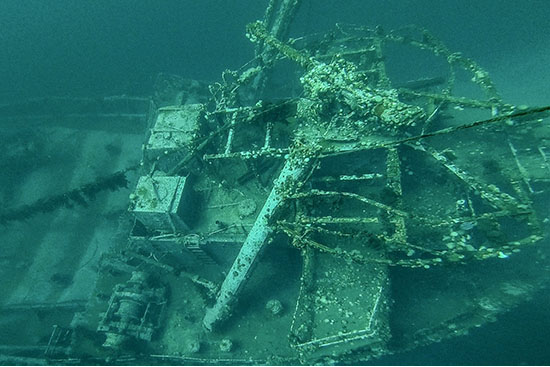Bell Island Wrecks

Caption
View of the S.S. Rose Castle on the sea floor as Canadian Forces Clearance Divers from Fleet Diving Unit Atlantic descend, during the UXO retrieval mission off the coast of Bell Island in Newfoundland, 19 July 2019.
(Source: Canadian Forces Combat Camera).
During the Second World War, Bell Island (in Conception Bay, Newfoundland) was the home to one of the largest iron ore mines in northeastern North America. It was considered a strategic resource due to its production of high-quality ore.
Prior to the war, almost half of the iron ore production from this mine was shipped to Germany but at the onset of hostilities, all shipments ceased and were instead re-directed to the allied war effort. In response, German U-boats were later dispatched to Conception Bay with the intent of disrupting or stopping the flow of this vital raw material to allied foundries. The end result would be torpedo attacks and the ultimate sinking of four armed iron ore carriers between September and November of 1942.

Caption
A Canadian Forces Clearance Diver from Fleet Diving Unit Atlantic combs the sea floor around S.S. Saganaga for unexploded explosive ordnance during the retrieval mission off the coast of Bell Island in Newfoundland, 16 July 2019.
(Source: MCpl Gabrielle DesRochers, Canadian Forces Combat Camera)
These ships, which are now collectively known as the Bell Island Wrecks, are comprised of the following allied vessels – the S.S. Saganaga, the Lord Strathcona, the S.S. Rose Castle, and the PML 27. These ships now rest on the bottom of Conception Bay, just south of Bell Island at depths ranging from 25-45 meters.
Tragically, 70 merchant mariners lost their lives due to the sinking of these vessels. The death toll would have been much higher however, had it not been for the bravery of the Bell Island residents and especially the residents of Lance Cove who dispatched boats to rescue survivors from the cold icy waters of Conception Bay.

Caption
A Canadian Forces Clearance Diver from Fleet Diving Unit Atlantic shows an unexploded explosive ordnance (UXO) on the S.S. Rose Castle wreck, during the UXO retrieval mission off the coast of Bell Island in Newfoundland, 19 July 2019.
(Source: Canadian Forces Combat Camera)
In recent years, the Bell Island Wrecks have increasingly been attracting many divers from around the globe. Estimates suggest that around 150 divers visit every year. The presence of WWII-era munitions within the wrecks posed a risk to divers. The ships were equipped with 4.75 inch deck guns, and were carrying projectiles and small arms ammunition. To remedy the situation, the Royal Canadian Navy performed Unexploded Explosive Ordinance (UXO) Risk Mitigation activities on the four WWII-era shipwrecks in 2019 and 2021. Approximately 200 pieces of ammunition were removed and destroyed from the four ships.